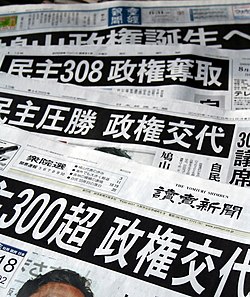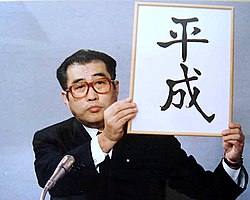Heisei period
| History of Japan |
|---|
 |
Heisei period (平成時代, Heisei jidai), also known as the Heisei era, is the Japanese era (年号,, nengō,, lit. "year name") after Shōwa and before Reiwa. This period started in February 1989[1] and ended on April 30, 2019 with the emperor's abdication.[2] During this time, the emperor was Akihito (明仁),[3]
Events of the Heisei period
The years in which Akihito has been the Japanese monarch comprise this period or era.[4]
- 1990 (Heisei 2): Expo 1990 in Hyōgo Prefecture
- 1992 (Heisei 4): Emperor Akihito traveled to China, the first time a Japanese monarch to visit.[5]
- 1993 (Heisei 5): 19th G7 summit in Tokyo
- 1998 (Heisei 10): 1998 Winter Olympics
- 2000 (Heisei 12): 26th G8 summit in Okinawa
- 2008 (Heisei 20): 34th G8 summit in Hokkaido
Disasters
- 11 March 2011 (Heisei 23, 11th day of the 3rd month): A magnitude 9.0 earthquake caused a great tsunami, known as the 2011 Tōhoku earthquake and tsunami[7] and consequently created the Fukushima nuclear disaster.
- 15 March 2011 (Heisei 23, 15th day of the 3rd month): Emperor Akihito made his first national television address. He said, "I hope from the bottom of my heart that the people will, hand in hand, treat each other with compassion and overcome these difficult times."[8]
Politics
- 1989 (Heisei 1): Emperor Shōwa died; and Noboru Takeshita was the Prime Minister during the time of transition.
- 1989 (Heisei 1): Sosuke Uno became 75th Prime Minister[9]
- 1989 (Heisei 1): Toshiki Kaifu became 76th Prime Minister[10]
- 1990 (Heisei 2): Kaifu became 77th Prime Minister[11]
- 1991 (Heisei 3): Kiichi Miyazawa became 78th Prime Minister[12]
- 1993 (Heisei 5): Morihiro Hosokawa became 79th Prime Minister[11]
- 1994 (Heisei 6): Tsutomu Hata became 80th Prime Minister[11]
- 1994 (Heisei 6): Tomiichi Murayama became 81st Prime Minister[11]
- 1996 (Heisei 8): Ryutaro Hashimoto became 82nd Prime Minister[11]
- 1996 (Heisei 8): Hashimoto became 83rd Prime Minister[11]
- 1998 (Heisei 10): Keizo Obuchi became 84th Prime Minister[11]
- 2000 (Heisei 12): Yoshiro Mori became 85th Prime Minister[11]
- 2000 (Heisei 12): Mori became 86th Prime Minister[11]
- 2001 (Heisei 13): Junichiro Koizumi became 87th Prime Minister[11]
- 2003 (Heisei 15): Koizumi became 88th Prime Minister[11]
- 2005 (Heisei 17): Koizumi became 89th Prime Minister[11]
- 2006 (Heisei 18): Shinzo Abe became 90th Prime Minister[11]
- 2007 (Heisei 19): Yasuo Fukuda became 91st Prime Minister[13]
- 2008 (Heisei 20): Taro Aso became 92nd Prime Minister[13]
- 2009 (Heisei 21): Yukio Hatoyama became 93rd Prime Minister[13]
- 2010 (Heisei 22): Naoto Kan became 94th Prime Minister[14]
- 2011 (Heisei 23): Yoshihiko Noda became 95th Prime Minister[15]
- 2012 (Heisei 24): Shinzo Abe became 96th Prime Minister[16]
- 2013 (Heisei 25)
- 2014 (Heisei 26)
- 2015 (Heisei 27)
- 2016 (Heisei 28)
- 2017 (Heisei 29)
- 2018 (Heisei 30)
- 2019 (Heisei 31)
Gallery
A special coin that was minted for the 1998 Winter Olympics
Heisei Period Media
Keizō Obuchi revealing the new era name to the press (7 January 1989)
Mount Fuji and Tokyo Skytree (2012)
Related pages
References
- ↑ Nussbaum, Louis-Frédéric. (2002). "Heisei" in Japan Encyclopedia, p. 306.
- ↑ BBC NEWS. (2017). Japan's Emperor Akihito to abdicate in April 2019
- ↑ Nussbaum, "Akihito" at p. 19.
- ↑ GlobalSecurity.org, Japanese years. Retrieved 2012-12-15.
- ↑ Sanger, David E. "Japan's Emperor Tells China Only of His 'Sadness' on War," New York Times. October 24, 1992. Retrieved 2011-12-15.
- ↑ Trends in Japan, "Earthquake Readiness: From Underground Stores to Satellite Monitoring," April 2, 1998]; U.S. Geological Survey (USGS), "Historic Earthquakes, Kobe, Japan" Archived 2016-12-09 at the Wayback Machine. Retrieved 2011-12-15.
- ↑ USGS, "Magnitude 9.0 Near the east coast of Honshu, Japan" Archived 2011-04-07 at the Wayback Machine. Retrieved 2011-12-25.
- ↑ Behr, Peter. "Radiation Levels Spike, Forcing Temporary Retreat by Reactor Emergency Workers at Fukushima," The New York Times. March 16, 2011. Retrieved 2011-12-15.
- ↑ Nussbaum, "Unō Sōsuke" at p. 1015.
- ↑ Nussbaum, "Kaifū Toshiki" at p. 450.
- ↑ 11.00 11.01 11.02 11.03 11.04 11.05 11.06 11.07 11.08 11.09 11.10 11.11 11.12 Kantei, 61st-90th (1964-2007). Retrieved 2011-12-15.
- ↑ Nussbaum, "Miyazawa Kiichi" at pp. 651-652.
- ↑ 13.0 13.1 13.2 Kantei, 91st- (2007-present). Retrieved 2011-12-15.
- ↑ Kantei, Previous cabinets (since 1996). Retrieved 2011-12-15.
- ↑ Kantei, Current Prime Minister. Retrieved 2011-12-15.
- ↑ Kantei, "Press Conference by Prime Minister Shinzo Abe". Retrieved 2013-1-23.
Other websites
![]() Media related to Heisei era at Wikimedia Commons
Media related to Heisei era at Wikimedia Commons
- National Diet Library, "The Japanese Calendar" -- historical overview plus illustrative images from library's collection
| Heisei | 1st | 2nd | 3rd | 4th | 5th | 6th | 7th | 8th | 9th | 10th | 11th | 12th | 13th | 14th | 15th | 16th | 17th | 18th | 19th | 20th |
|---|---|---|---|---|---|---|---|---|---|---|---|---|---|---|---|---|---|---|---|---|
| 1989 | 1990 | 1991 | 1992 | 1993 | 1994 | 1995 | 1996 | 1997 | 1998 | 1999 | 2000 | 2001 | 2002 | 2003 | 2004 | 2005 | 2006 | 2007 | 2008 |
| Heisei | 21st | 22nd | 23rd | 24th | 25th | 26th | 27th | 28th | 29th | 30th | 31st |
|---|---|---|---|---|---|---|---|---|---|---|---|
| 2009 | 2010 | 2011 | 2012 | 2013 | 2014 | 2015 | 2016 | 2017 | 2018 | 2019 |
| Preceded by: Shōwa |
Era or nengō: Heisei |
Succeeded by: Reiwa |









